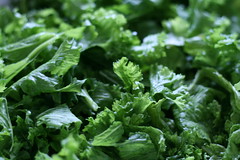After years of silence on the topic of food waste, our federal government has released a study on the topic. The Economic Research Service (ERS), the research wing of the Deptartment of Agriculture, has kicked in with a study on supermarket food loss (view the full report here).
The long-anticipated (at least in these quarters) report provides supermarket loss estimates for each individual fruit and vegetable, in addition to types of meat, poultry and seafood. Before, the USDA simply estimated a 7 percent loss rate for all fruits and vegetables and 12 percent for meats, poultry and seafood.
As we see in the summary of findings, the range of loss varies greatly. If one  generalization can be made, it’s that unusual items are wasted the most. Based on an average of two years’ data, we learn that 64 percent of mustard greens and 55 percent of papayas are squandered. In a meatier topic, 25 percent of veal and 12 percent of lamb/goat aren’t used.
generalization can be made, it’s that unusual items are wasted the most. Based on an average of two years’ data, we learn that 64 percent of mustard greens and 55 percent of papayas are squandered. In a meatier topic, 25 percent of veal and 12 percent of lamb/goat aren’t used.
On the brighter side, only 4 percent of chicken and beef and less than 1 percent of corn is wasted. King Corn, indeed.
This ERS study reminds us how much more research is needed, because it only has findings from one portion of one segment of the food chain. The authors note that the study omits data from “megastores, club stores, mom-and-pop grocery stores, or convenience stores.”
Still, it brings us one step closer to having an accurate idea on the amount of food we waste.
5 Comments